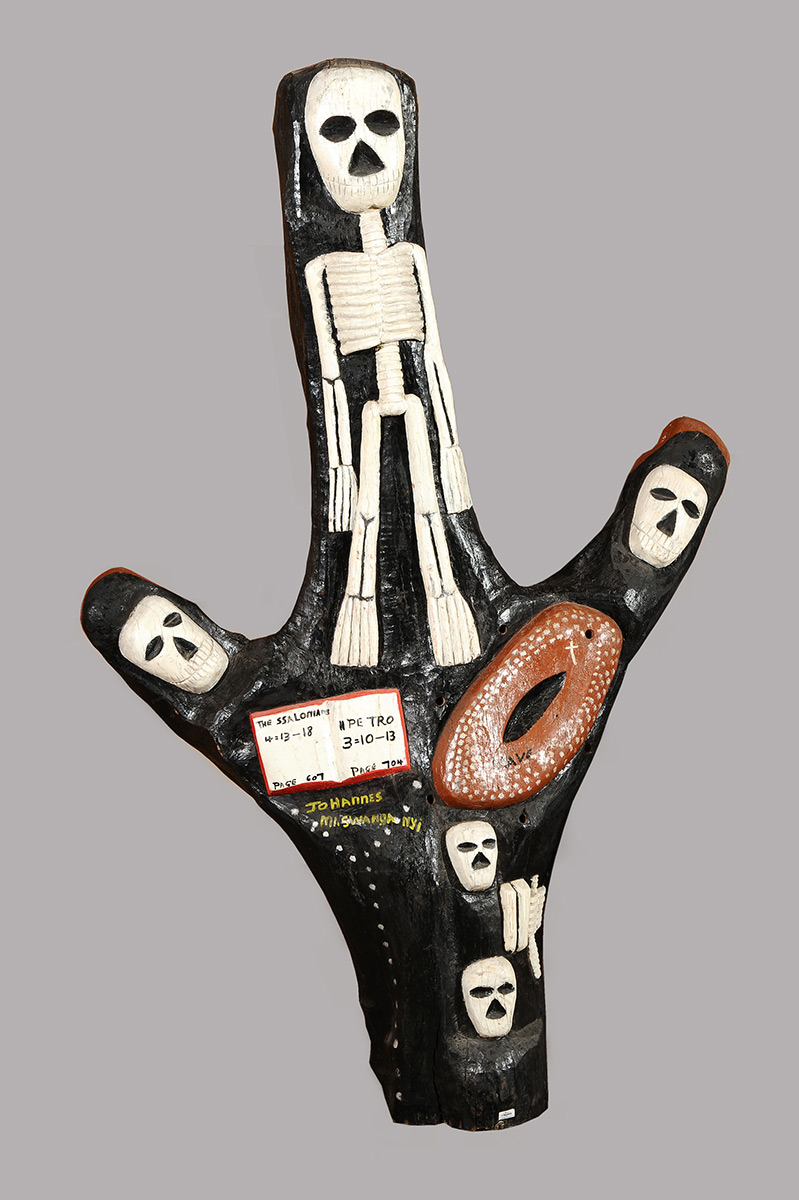Johannes MASWANGANYI (b. 1949)
BIOGRAPHY
Johannes Maswanganyi was born in Ka Msengi Village, near Giyani, Limpopo Province. During the period of Apartheid forced removals, his family and most of the people under the leadership of Chief Msengi, were moved to Noblehoek Village, about 15 kilometres north of Belleview, where they now reside.
Maswanganyi learnt the skill of wood carving from his uncle Piet Mafemani Maswanganyi, who took custody of him and and his siblings after the death of his father when he was just 11 years old. His uncle was a notable carver, who taught him to carve traditional and functional items like wooden plates, spoons, forks and trays with wooden chains.
One of the most important tools his uncle made was an Mbatlo (a ‘chopper’ in English), which became a Maswanganyi family legacy tool, used by the late Piet Mafemani Maswanganyi, passed on to Johannes Maswanganyi, and then to Collen and Amorous Maswanganyi. The Mbatlo tool brought prosperity to the Maswanganyi family.
Johannes Maswanganyi began by selling his carvings in nearby villages. While refining his skills, he expanded his territory to local farms and would travel by bicycle for about 40 kilometres to sell his artefacts to ZZZ, a well-known tomato farm in Limpopo. But pressure kicked in. Most of his peers were moving to Gauteng and other places in search of greener pastures. Art was not regarded as work that could generate a good living. He got a job with a construction company in Rustenberg, then moved to Tembisa, then found work in a brick-making company in Olifantsfontein, then got a job at a bakery… But none of these jobs lasted very long because wood carving was his passion.
So he returned home to follow his calling. Having navigated his way around the City of Gold, he began to sell his carvings to people as far afield as Soweto. Most of his buyers were traditional healers who bought things like his Nyamisoro and Nhunguvani sculptures, which were used as a muti containers.
It was his Nyamisoro sculpture this introduced Maswanganyi to the mainstream art industry. In 1985, he met curator Ricky Burnett via a Soweto-based traditional healer called Peggy Moeketsi, who was one of his clients.
His first exhibition was the famous BMW-sponsored Tributaries exhibition (1985), curated by Burnett. That exhibition paved the way for Maswanganyi, who went on to show his work with Goodman Gallery, Everard Read Gallery, Helen De Leeuw, Natalie Knight and many others.
The question was how the art world was trying to place his work. To some, his work was craft, while to others, it was art…
Wits Art Museum senior curator Julia Charlton referred to him as ‘an artist entrepreneur’, who would not wait for clients and art collectors to come to him but would drive with art in the back of his bakkie all the way from Giyani in Limpopo, and organise meetings and visits in Johannesburg and Pretoria to show his work to art galleries, dealers and collectors alike. He even drove as far as Durban and Cape Town, chasing the horizon, as he felt that he needed to show his work to as many aspiring collectors as he could. This broadened his popularity and collector base.
Maswanganyi is the father of 11 children from two wives. His first born son, Collen Maswanganyi, has followed in his footsteps, studying Fine Art the Technikon Witwatersrand (now the University of Johannesburg) and practising art full time.
Through Collen’s facilitation, Johannes Maswanganyi was honoured as a main festival artist at Klein Karoo Nationale Kunstefees (KKNK) in 2018. At the same festival, Collen Maswanganyi was awarded ‘New Voice: KKNK 2018’.
Their collaborative exhibition Carve and Dance with My Father was chosen as best presentation in visual art at the Kanna Awards in 2018.
Johannes Maswanganyi has participated in numerous solo and group exhibitions locally and internationally. Locally, his works can be found in prominent collections like Johannesburg Art Gallery, Standard Bank Art Collection, Unisa Art Gallery, Javett Centre, Pretoria Art Museum, Wits Art Museum, Sasol, Tzaneen Art Museum, Polokwane Art Museum, AVA Gallery.
As well as opening the doors to the art world for his son, Maswanganyi has supported many other artists – including Settlers Chavalala, Richard Chauke Amorous Maswanganyi, Doctor Ngoveni – in their careers. He has also helped many women bead workers and potters from Limpopo to distribute and sell their work in Johannesburg and elsewhere.


